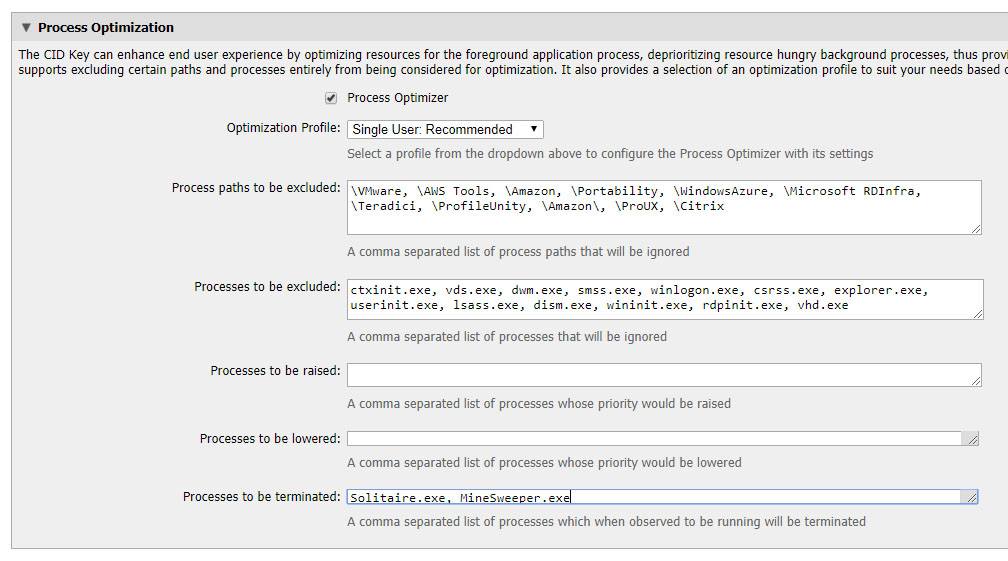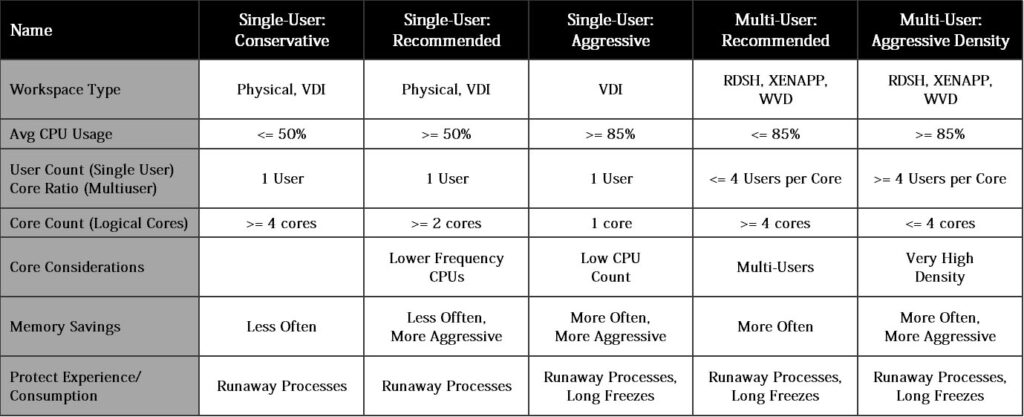Six months ago we added Process Optimization to the Stratusphere Connector ID Key (CID Key). With the upcoming release of Stratusphere UX 6.1.3, we’ve added some important enhancements to the feature. For those not familiar, Process Optimization helps minimize the effects of poorly performing applications and processes by prioritizing the CPU resources available to those that are in-focus by the end user. In short, this set-it-and-forget-it Stratusphere UX feature provides a user experience safety net. A safety net to ensure in-focus applications get the resources they need, but also to guard against unplanned-for background processes (and memory—more on that in a bit) causing a negative effect on user performance.

Specifically, Process Optimization intelligently protects against user experience issues pertaining to the in-focus application. This can be caused by background applications or processes that hog resources, where there is a general lack of available resources, or due to a virus, malware or other processes that monopolize available resources. Process Optimization is especially important with respect to older and underperforming machines, where the balance and native handling of Windows resources can be jarring to the user experience, creating performance challenges that are not easy to address; short of a hardware upgrade, or system replacement.
Over the last half a year, we’ve heard from customers who greatly recognize this benefit; and have adopted Stratusphere UX for just this feature alone. And in cases where Process Optimization has been turned on—in trial or limited rollout—it has been a challenge for IT personnel to remove the feature. The significant performance-boosting benefit experienced by end users make it difficult to live without.
But What About Memory?
While the Stratusphere UX Process Optimization feature keys off of CPU resources, it also provides an important benefit to overall RAM utilization. Without getting into the complexities of Windows memory management, I will profoundly over-simplify the net effect here… I should add, the cause-effect behavior is true for physical PCs, virtually delivered host-centric workspaces (think VDI, RDS and other multi-session host-based computing) as well as for cloud-delivered workspaces.
RAM, both physical and virtual, and the overall management of resources in low-memory situations have a profound effect on workspace performance. Windows normally relies on paging and swapping of content from memory. And at times can have a wildly unsystematic effect on overall performance (from a user’s point of view). Windows does not approach memory management with kid gloves. In fact, when the upper boundary of available memory resources is reached, Windows will take dramatic action to get a handle on memory allocations.
The Stratusphere UX Process Optimization feature clears-out memory on a rolling basis. This laser-focus allow us to take a more targeted approach to resource management. When a Windows workspace nears this memory use boundary, memory thrashing, increasing page faults and other performance issues typically occur; with the end result being a poor user experience. This scenario is amplified on undersized and older hardware, as well as with poorly written applications. Again, the primary ‘fix’ is to replace applications, replace hardware, and/or re-provision virtual machines. All of these fixes can be a costly—and an unplanned for—path to resolution.
A Focus on the Application
Ultimately, the issue at hand is application performance and user experience, not managing CPU or RAM. Prioritizing the applications that matter most is not only the simplest management approach, but abstracts much of the complexity—again, I restate a set-it-and-forget-it approach. The ability to tie Stratusphere UX Process Optimization to specific applications, and/or specific groups of machines (perhaps due to their age, or due to patching, think Spector and Meltdown) is our primary goal; and it happens to also be the least path of resistance.

Stratusphere UX Connector ID Key Administration
Process Optimization is an option that can be easily managed. The feature can be applied to specific users, specific machines (either machine groups, or make and models). Setting are available for defining profile types, which are tuned for both aggressiveness and your Windows delivery approach (physical PCs versus multi-user environments). The chart below shows some of the profile configuration and behavioral attributes.

Additionally, the Stratusphere UX Process Optimization feature provides for the ability to exclude a complete application path, a specific application or process as well as settings that manage processes that should automatically be raised and lowered—regardless of whether these are ‘in-focus’ applications. Further, the feature provides for the ability to outright terminate specific application or processes, should you wish to manage to an absolute blacklist.
Customers have been very excited about this feature and love the laser focus Stratusphere UX brings to CPU and memory management. The set-it-and-forget-it ease of manageability allows you to cast a safety net for application performance while optimizing end user experience. Let me know your thoughts; I’m always interested in learning more about how you prioritize and manage application and user experience.








Leave A Comment
You must be logged in to post a comment.